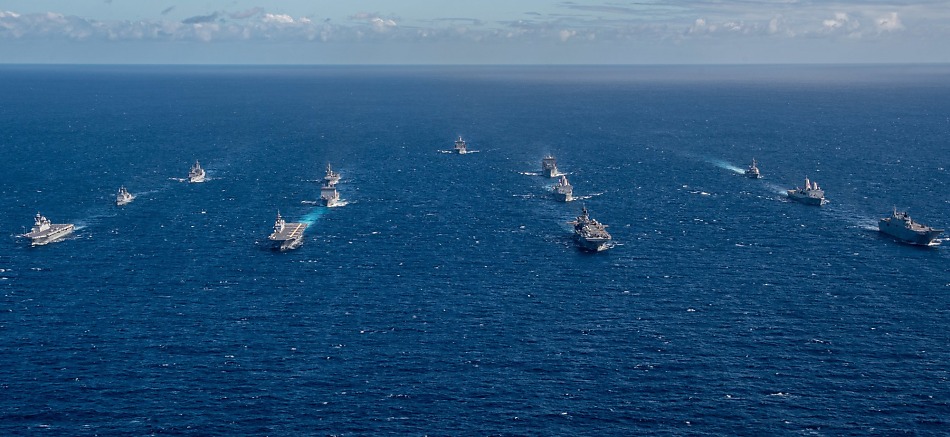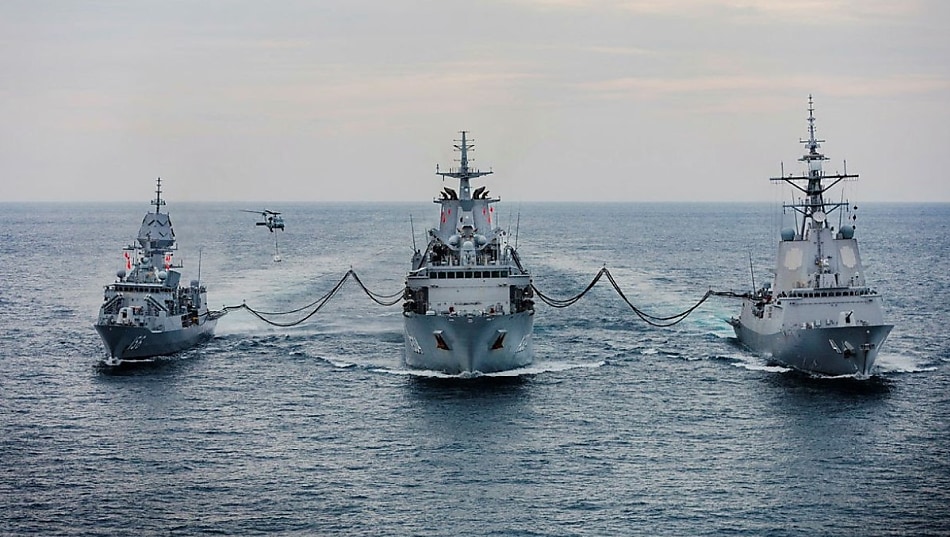
The forward-deployed amphibious assault ship USS America sails in formation with the Royal Australian Navy Canberra Class landing helicopter dock ship HMAS Adelaide, Japan Maritime Self-Defense Force helicopter destroyer JS Izumo, Republic of Korea Navy amphibious assault ship Marado, amphibious transport dock ship USS Green Bay, amphibious assault ship USS New Orleans, Royal Australian Navy landing ship HMAS Choules, Republic of Korea Navy destroyer Munmu The Great, guided-missile destroyer USS Rafael Peralta, dry cargo ship USNS Matthew Perry, Japan Maritime Self-Defense Force tank landing ship, JS Shimokita, Royal Australian Navy replenishment oiler HMAS Stalwart and fleet replenishment oiler USNS Tippecanoe during a formation exercise, as part of Exercise Talisman Sabre, 29 July 2023. Photo: US Navy photo by Mass Communication Specialist 2nd Class Thomas B. ContantSenator Roberts made the accusations during a Senate foreign affairs, defence and trade legislation committee (Senate estimates) meeting on 14 February.
The MRH-90 Taipan helicopter impacted waters near Lindeman Island around 11pm on 28 July last year. Military and civilian search and rescue aircraft and watercraft were tasked with search rescue and recovery operations at the incident site on 29 July immediately following the crash.
Aircrew lost during the night-time training activity included Captain Danniel Lyon, Lieutenant Maxwell Nugent, Warrant Officer Class Two Joseph Laycock, and Corporal Alexander Naggs.
HMAS Huon minehunter, Australian Defence Vessel Reliant and Royal Australian Navy clearance divers later recovered items such as crew personal effects, helicopter and a voice and flight data recorder.
“The United States Navy has taken a photo and it’s dated 29 July. It’s an obvious photo shoot of the Talisman Sabre fleet and, in it, they say that the American ships are sailing in formation with the Royal Australian Navy Canberra Class landing helicopter dock ship HMAS Canberra as part of the Talisman Sabre photo shoot,” Senator Roberts said during the meeting.
“This shows an Australian vessel at the photo shoot on the 29th and it wasn’t searching for the wreckage or the bodies from the downed Taipan.
“Were you embarrassed about the ship not being engaged in the search area, but off on a photoshoot?”
Senator Roberts had previously requested a list of vessels present in the area of operations and those tasked to the search and rescue operation, which was taken on notice during a Senate meeting in October last year. He was later allegedly notified by the Defence Department that “Defence does not comment on the operational tasking of its assets”.
Chief of the Defence Force General Angus Campbell, speaking at the Senate estimates, said Defence staff were correct in advising Senator Roberts that the department does not comment on operational tasking.
“I know that our people engaged in that exercise were very conscious of how to be of assistance in supporting that downed aircraft and, at that stage, the missing aircrew,” he said.
“Defence doesn’t comment on the operational tasking of its assets. That is correct, we don’t.
“But I want to reinforce the assurance that every asset that could be of assistance from Australia or from any of our partner nations in that exercise was tasked to be of assistance.
“This photograph is out in open water, in an extended area. There are some ships in the Australian fleet and, indeed, in the US and international partner fleet, that are not suited to the work required in confined waters and with variable depths to deal with searching for a lost helicopter and crew.
“There’s a distinction here between what is suitable and hence applied to the search and what is not suitable and not considered for the search.”
General Campbell also confirmed that HMAS Adelaide, HMAS Choules and HMAS Stalwart alongside vessels from United States Navy, the Japan Maritime Self-Defense Force and the Republic of Korea took part in a photo shoot on July 29.
“The location of the photo shoot was approximately 142 nautical miles away from the crash site. While it was underway at about 0845 hours HMAS Adelaide was tasked to support the accident site in addition to those vessels already responding,” he said.
“HMAS Adelaide immediately departed the activity. The entire photo exercise was then cancelled upon receipt of HMAS Adelaide’s tasking to support search activities. HMAS Adelaide was also tasked once it was identified that additional aviation assets and logistics support was required.
“The nature of the operating environment, including constrained waters and tidal flows, limited the number of vessels that could freely navigate the identified search area.”
Royal Australian Navy Chief of Navy Vice Admiral Mark David Hammond, speaking at the Senate meeting, further clarified that the resources available with necessary capabilities were applied at speed during the search and rescue operation.
“That large array of ships in the photograph is in open water, some distance from land. It is routine to mark the beginning or the end of a large naval exercise with a group photograph,” he said.
“There are Australian ships that are not in that photograph, because they were engaged in the search and rescue effort in confined waters inside the Whitsunday Islands.
“Had all of those ships been in that search area, we would have had a problem; there just isn’t enough sea room.
“The focus was on conducting a surface search initially for survivors, as I understand it, and for signs of wreckage. There were civilian craft involved and there were aircraft, rotary wing and fixed-wing, and there was no shortage of assets for that search; that very tragic incident.
“I understand your frustration. I am not in a position to answer why there was not a more fulsome response.”
Senator Roberts concluded that Defence had been excessively evasive in its response for no apparent reason.
“When we’ve seen what we’ve seen with the Taipans and been horrified by the loss of life on those Taipans, and then we see the nice photo shoot that we were on, we have a duty to ask those questions,” he said during the Senate estimates meeting.
“We didn’t get the damn answers. We were led astray. It was suppressed.
“What you have said makes sense to me. You’re not going to have a US aircraft carrier ploughing around in the Whitsundays looking for a helicopter; I get that. You had at least one boat out in open waters; I get it. Why couldn’t we have been told that? What is Defence repeatedly trying to hide?
“We have seen issue after issue which Defence seems sensitive about.
“There are many issues that have not been talked about openly … It is not just my frustration; it is my deep sadness at the loss of life which seems to have been unnecessarily lost in those Taipans. It borders on anger, though, when it could have been avoided.”
The Defence Member and Family Helpline is the first point of call for Defence members and families seeking support, information or connection with their community. They can be reached 24 hours a day, seven days a week on 1800 624 608.
Open Arms veterans and families counselling provides free and confidential counselling and support for current and former serving ADF members and their families. They can be reached 24 hours a day, seven days a week on 1800 011 046 or visit the Open Arms website for more information.
from Blogger https://ift.tt/1V45npz
via IFTTT
Like this:
Like Loading...





























